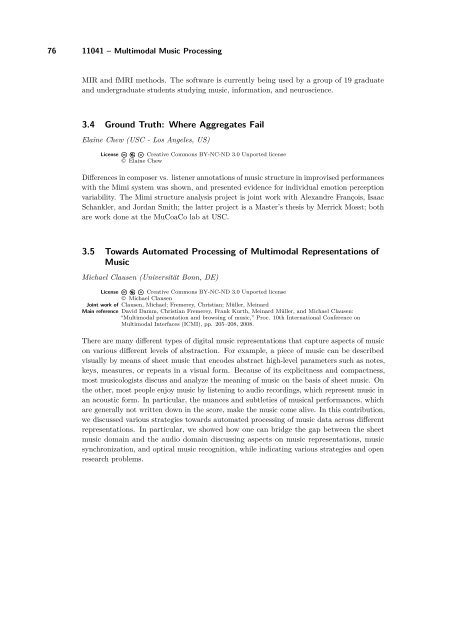Volume 1, Issue 1, January 2011 - DROPS - Schloss Dagstuhl
Volume 1, Issue 1, January 2011 - DROPS - Schloss Dagstuhl
Volume 1, Issue 1, January 2011 - DROPS - Schloss Dagstuhl
Create successful ePaper yourself
Turn your PDF publications into a flip-book with our unique Google optimized e-Paper software.
76 11041 – Multimodal Music Processing<br />
MIR and fMRI methods. The software is currently being used by a group of 19 graduate<br />
and undergraduate students studying music, information, and neuroscience.<br />
3.4 Ground Truth: Where Aggregates Fail<br />
Elaine Chew (USC - Los Angeles, US)<br />
License Creative Commons BY-NC-ND 3.0 Unported license<br />
© Elaine Chew<br />
Differences in composer vs. listener annotations of music structure in improvised performances<br />
with the Mimi system was shown, and presented evidence for individual emotion perception<br />
variability. The Mimi structure analysis project is joint work with Alexandre François, Isaac<br />
Schankler, and Jordan Smith; the latter project is a Master’s thesis by Merrick Mosst; both<br />
are work done at the MuCoaCo lab at USC.<br />
3.5 Towards Automated Processing of Multimodal Representations of<br />
Music<br />
Michael Clausen (Universität Bonn, DE)<br />
License Creative Commons BY-NC-ND 3.0 Unported license<br />
© Michael Clausen<br />
Joint work of Clausen, Michael; Fremerey, Christian; Müller, Meinard<br />
Main reference David Damm, Christian Fremerey, Frank Kurth, Meinard Müller, and Michael Clausen:<br />
“Multimodal presentation and browsing of music,” Proc. 10th International Conference on<br />
Multimodal Interfaces (ICMI), pp. 205–208, 2008.<br />
There are many different types of digital music representations that capture aspects of music<br />
on various different levels of abstraction. For example, a piece of music can be described<br />
visually by means of sheet music that encodes abstract high-level parameters such as notes,<br />
keys, measures, or repeats in a visual form. Because of its explicitness and compactness,<br />
most musicologists discuss and analyze the meaning of music on the basis of sheet music. On<br />
the other, most people enjoy music by listening to audio recordings, which represent music in<br />
an acoustic form. In particular, the nuances and subtleties of musical performances, which<br />
are generally not written down in the score, make the music come alive. In this contribution,<br />
we discussed various strategies towards automated processing of music data across different<br />
representations. In particular, we showed how one can bridge the gap between the sheet<br />
music domain and the audio domain discussing aspects on music representations, music<br />
synchronization, and optical music recognition, while indicating various strategies and open<br />
research problems.













